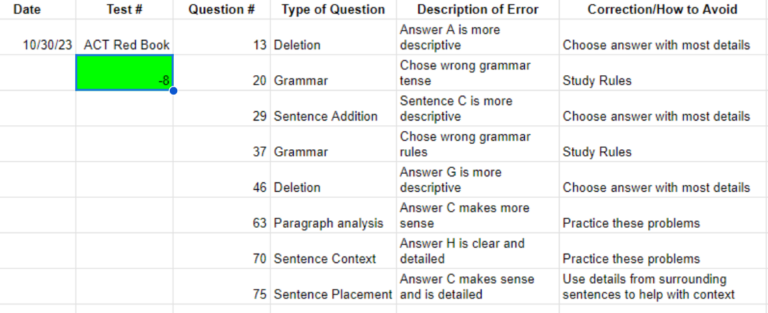Preparing for the SAT or ACT can be a challenging and, at times, frustrating experience. As you tackle practice questions and mock tests, you’re bound to make mistakes and encounter incorrect answers. While it’s natural to feel disheartened by these errors, they can actually be powerful tools for improvement if you can shift your perspective to a growth mindset.
In fact, tracking your errors systematically can be one of the best ways to distance yourself from the negative emotions that arise when you get questions wrong and to develop alternatives that improve your performance on these tests. In this blog post, we’ll explore the benefits of maintaining an error log and provide a step-by-step guide on how to create and use one effectively.
The Importance of an Error Log
Identifying Patterns
When you make a mistake on a practice question or a mock test, it’s easy to dismiss it as a one-off error. However, these errors can often reveal recurring weaknesses or misconceptions. By logging them, you can start to identify patterns in your mistakes. Do you consistently struggle with a particular question type? Are there specific topics or concepts that consistently trip you up? Identifying these patterns is the first step toward targeted improvement.
Focus on Weaknesses
Your time and energy are precious resources when preparing for standardized tests. An error log allows you to zero in on your weaknesses. Instead of reviewing everything, you can concentrate on the areas where you’re most likely to make mistakes. This focused approach can help you make efficient use of your study time.
Tracking Progress
As you work through your study materials and practice tests, your error log serves as a record of your progress. Over time, you can see how your error rate decreases and how you’re conquering those tricky questions that once stumped you. This can be a source of motivation and encouragement during your test preparation journey.

An example of a spreadsheet error log
Creating an Effective Error Log
Now that we’ve discussed the benefits, let’s delve into how to create an error log:
- Choose a Medium: You can create a physical notebook, a digital document, or even use a dedicated app or tool. The key is to find a method that works for you and is easily accessible.
- Record the Basics: For each error, record the question number, the section it came from (math, reading and writing, etc.), and the date. This helps you organize your log and track your progress over time.
- Identify the Mistake: Describe the specific mistake you made. Was it a calculation error, a misinterpretation of the question, or a lack of understanding of the underlying concept?
- Note the Correct Answer: Write down the correct answer or solution to the question. This will be crucial for reviewing your errors later.
- Analyze the Error: Reflect on why you made the mistake. Was it a lack of knowledge, a misinterpretation of the question, or simply a careless error? Understanding the root cause of your mistake is essential for improvement.
- Tag the Concept: Assign a tag or label to each error that indicates the concept or topic it is related to. This will help you spot patterns in your weaknesses.
- Set Action Items: For each error, create an action item or a plan to avoid making the same mistake in the future. This might involve studying specific topics, changing your approach to certain question types, or improving your test-taking strategies.
Using Your Error Log Effectively
Having an error log is one thing; using it effectively is another. Here are some tips for making the most of your error log:
- Regularly Review Your Log: Set aside time to go over your error log periodically, whether it’s weekly or monthly. This ensures that you’re addressing your weaknesses systematically.
- Adapt Your Study Plan: Use the insights from your error log to adjust your study plan. Focus more on the concepts or question types that consistently trip you up.
- Stay Positive: Remember that mistakes are opportunities for growth. Don’t get discouraged by the errors in your log; instead, view them as stepping stones to success. You’re much better prepared to correct any mistakes you’ve made when you know what those mistakes are in the first place!
- Simulate Test Conditions: When reviewing your errors, try to recreate test conditions as closely as possible. This helps you practice problem-solving under the same time constraints and pressure you’ll face during the actual SAT or ACT.
Conclusion
Creating and maintaining an error log is an invaluable tool for SAT and ACT preparation. It allows you to turn your mistakes into opportunities for growth and improvement. By systematically identifying and addressing your weaknesses, you can approach the tests with greater confidence and a better chance of success. So, start your error log today and watch as your progress soars on your journey to acing the SAT or ACT.
At Mindfish, we create score reports for every single test we use. As a result, our tutors are able to help students identify their most challenging areas on the SAT and ACT, develop a plan of action to answer these types of questions, and track improvements in error rate. If you’re struggling with the SAT or ACT and are looking to diagnose your performance, consider our Practice Test Program and 1-on-1 Test Prep Tutoring. Our Admin team can guide you toward a program that is tailored to you and will help maximize your score. Reach out to us at (720) 204-1041 or admin@mindfish.com.
Interested in learning more about Test Prep at Mindfish?
Contact us today to find out what our dedicated tutors can help you achieve.





